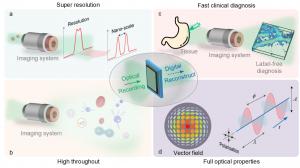
Quantitative phase imaging based on holography: trends and new perspectives
USA, August 30, 2024 /EINPresswire.com/ -- In 1948, Dennis Gabor proposed the concept of holography. After 75 years of development, holographic imaging has become a powerful tool for optical wavefront measurement, which has given fresh energy to physics, biology, and materials science. Scientists in China regard the process of holographic recording and reconstruction as a transformation between complex-domain and real-domain, and discuss the mathematics and physical principles of reconstruction. The multidisciplinary nature brings it to label-free biology, wavefront sensing, and semiconductor production.
An accurate depiction of how waves spread in space and time is essential to the investigation of physical objects and their interactions with waves. In 1948, Dennis Gabor proposed the concept of holography. After 75 years of development, holography has become a powerful tool for quantitative phase measurement. Holographic recording and playback of waves have been used in numerous applications, including biological sample analysis, material representation, and material structure analysis.
In a new paper (https://doi.org/10.1038/s41377-024-01453-x) published in Light Science & Applications, a team of scientists, led by Professor Liangcai Cao from the Department of Precision Instrument, Tsinghua University, China introduces the fundamental problem of Digital holography (DH) and traces the development of methods to solve this problem. They regard the process of holographic recording and reconstruction as a transformation between complex-domain and real-domain, and discuss the mathematics and physical principles of reconstruction. They conclude with emerging challenges and opportunities based on combining holographic imaging with other methodologies that further expand the scope and utility of holographic imaging. The multidisciplinary nature brings technology and application experts together in label-free cell biology, analytical chemistry, clinical sciences, wavefront sensing, and semiconductor production.
With the increasing availability of computational resources, these solutions have increasingly converged, leading to several key applications in quantitative biology and a dramatic increase in research interest in DH. The propagation of wavefront is described by the complex amplitude. Only the intensity-value measurement in the real-domain can be recorded by the camera due to the high-frequency oscillation of visible light. How to calculate the phase shift becomes the necessary link with the help of additional optical configurations and computational algorithms. This is the fundamental problem of DH, which has stimulated the development of multiple DH techniques, as shown in Fig. 1. The development of DH in the context of these solutions has been discussed, focusing on the primary approaches that have had a significant impact on modern holographic methods and applications: digital holography, optical diffraction tomography, phase retrieval, holographic multiplexing and deep learning.
By reconstructing the complex-amplitude of the optical field, the interpretation of the phase signal has proven to deliver important novel parameters for studying physiological processes in living cells, such as transmembrane fluid flux, dry mass intracellular transport as well as tissue structure and density changes. The interpretation has also been proven for monitoring the wet etching process, and dynamic topographic changes at the nano-device, soft material, and industrial device. The technology is transferred from engineering to biomedical laboratories. there are still several important theoretical and technical issues that deserve to be further studied, as shown in Fig. 2. Novel, high-impact, and some currently unexplored applications will surface. Commercialization efforts and application-driven academic collaborations across disciplines are key for these future developments.
DOI
10.1038/s41377-024-01453-x
Original Source URL
https://doi.org/10.1038/s41377-024-01453-x
Funding information
National Natural Science Foundation of China (NSFC) (62235009)
Lucy Wang
BioDesign Research
email us here
Distribution channels: Science, Technology
Legal Disclaimer:
EIN Presswire provides this news content "as is" without warranty of any kind. We do not accept any responsibility or liability for the accuracy, content, images, videos, licenses, completeness, legality, or reliability of the information contained in this article. If you have any complaints or copyright issues related to this article, kindly contact the author above.
Submit your press release

